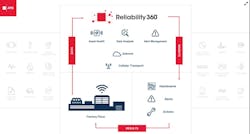Factory equipment and technology downtime is expensive. How expensive? How about as much as $110,000 on average per hour. How do manufacturers avoid downtime which can be that pricey? Plan ahead and budget for retrofitting but also recognize that “legacy equipment doesn’t necessarily mean ancient” and it can be brought along, at least for a time, during a manufacturer’s digital transformation.
This was perhaps the top lesson on Day 2 of this week’s Fall Insight Series of webinars on extending the life of legacy equipment through "condition monitoring."
Next up: Surf Loch Catches the Wave with Siemens Xcelerator to Deliver Custom Surfing Experiences
Micah Statler, director of industrial technologies for contract industrial maintenance, technology, and parts provider Advanced Technology Services, was the presenter of the Oct. 3 webinar in the series. ATS also sponsored the online event while Smart Industry Editor-in-Chief Robert Schoenberger moderated. A recording of the webinar—as well as the others in the series—is available now.
The cost of not acting often is higher than putting a plan in place that might itself come with a high price tag and need to be budgeted, Statler emphasized.
Later this week: Lessons From The Frontlines Of Machine Learning
As such, the CM approach is proactive and predictive and not reactive, Statler told webinar attendees.
“Legacy is something that sneaks up on us every day,” he said, noting that non-networked plant equipment and technology is difficult—but not impossible—to monitor using remote support. “Legacy doesn’t necessarily mean ancient; it may not be supported by an OEM from a parts perspective, for example. There are alternatives to get more out of those pieces of equipment.”
Be proactive and predictive, not reactive when a breakdown occurs
Statler added later in the program: “Plan the 'what-ifs,' treat the problem as if it already happened. We want to be proactive to drive less downtime.” That might mean a CTO or an IT department gigging out the cost of new equipment vs. retrofitting legacy systems, finding partners who specialize in legacy control units, and figuring out parts availability before someone in the back office has to resort to scrolling through eBay for parts while the downtime meter reaches large sums per hour in idled employee time or a fortune in expedite fees later when equipment is back up and humming and the manufacturer is playing catch-up.
To close out the series: How To Capitalize On Generative AI
Still, downtime does happen, but Statler emphasized that companies must plan for it. “When you’re reacting to something in the future, you’re proactive. It’s going to allow you to drive better asset availability,” he said, adding: "Ultimately what you need from the condition monitoring program is you never get an alert from it, that things are working the way they are supposed to be working.”
The Oct. 3 webinar also covered details of retrofitting, data, information security, and shielding condition-monitored systems from cyber threats such as severe ransomware attacks of the kind that recently idled bleach maker Clorox. Ultimately, the program provided a roadmap for future-proofing—even the most dated industrial equipment that might be decades old—common challenges legacy systems pose for digital transformation, practical approaches to improve equipment reliability through predictive technology, and the best KPIs on the front line and what data is most valuable to the C-suite.




